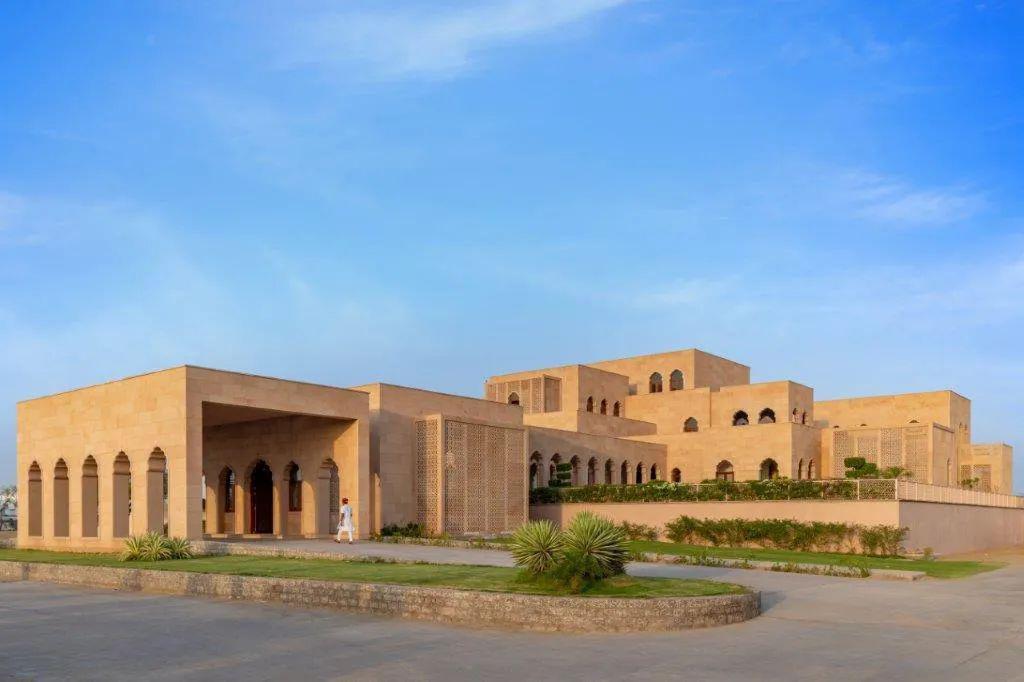房屋位于印度拉贾斯坦邦 Nokha 的干旱沙漠地区,吸收了拉贾斯坦邦几个世纪以来流行的区域建筑的传统规划原则。 Situated in the arid desert region of Nokha in Rajasthan, India, the Narsighar house imbibes the traditional planning principles of the regional architecture prevalent for centuries in Rajasthan.
房屋位于印度拉贾斯坦邦 Nokha 的干旱沙漠地区,吸收了拉贾斯坦邦几个世纪以来流行的区域建筑的传统规划原则。
Situated in the arid desert region of Nokha in Rajasthan, India, the Narsighar house imbibes the traditional planning principles of the regional architecture prevalent for centuries in Rajasthan.
几个世纪以来,在该地区建造的大多数房屋和宫殿都有用于被动冷却的庭院,厚厚的石墙以对抗过热,以及用于减轻热量增加的石“jali”屏幕。
Most of the houses & palaces built in this region for centuries had courtyards for passive cooling, thick stone walls to combat the excessive heat and stone ‘jali’ screens to mitigate heat gain.
Narsighar 房屋点缀着一系列庭院,建在附近的当地砂岩中。每个起居空间都通向有穿孔石板屏蔽的有遮蔽的户外空间。这些屏幕除了减少热量增加外,还可以保护内部空间免受该地区普遍存在的沙尘暴的影响。
The Narsighar house is punctuated with a series of courtyards and is built in the local sandstone available in the immediate vicinity. Each of the living spaces opens into sheltered outdoor spaces screened with perforated stone panels. These screens, in addition to reducing heat gain, also protect the inner spaces from the sandstorms prevalent in the region.
根据客户的需求,可容纳4代人的房屋有9间卧室,多功能起居空间,有遮蔽的庭院和露台。
The home based on the client's needs to accommodate 4 generations has 9 bedrooms with multifunctional living spaces, sheltered courtyards, and patios all around.
除了传统的规划原则外,传统拉贾斯坦邦建筑的元素,包括多层拱形窗户、图案石屏风、石制凉棚、镶嵌作品和雕刻作品,都突出了空间。在印度,拉贾斯坦邦是许多工匠的故乡,他们擅长石雕、大理石镶嵌、木工工作、镜面镶嵌、石灰抹灰等。整栋房子都是由这些当地工匠执行和加工的,恢复了许多传统技术。
In addition to the traditional planning principles, elements of traditional Rajasthan architecture, including multifoil arched windows, patterned stone screens, stone pergolas, inlay work, and carving work, accentuate the spaces. In India, Rajasthan is home to many craftsmen with specialties in stone carving, marble inlay, carpentry work, mirror work inlay, lime plastering, and more. The entire house was executed and worked upon by these local craftsmen, reviving many traditional techniques.
虽然房子看起来很大,但超过40%的面积是开放式庭院、流通空间和有遮蔽的户外露台。每个体量都是单独表达的,家被认为是不同体量的组合。
Although the house appears large, over 40% of the area is in the form of open courtyards, circulation spaces, and sheltered outdoor patios. Each volume is articulated individually, with the home being perceived as a composition of varying volumes.
入口处的汽车门廊通向一个阳光明媚的庭院,该庭院通向一个有遮蔽的石头拱廊,两侧是水槽和花园,用于在进入房屋之前进行被动冷却。房子内的天窗入口大厅,两侧是客厅和开放式休息区,通向一个大型中央庭院。
An entry car porch opens into a sunlit courtyard that leads to a sheltered stone arcade, flanked by water troughs and gardens for passive cooling before one enters the house. The skylit entrance lobby within the house, flanked by a living room and an open seating area, leads one into a large central courtyard.
贯穿房屋的主庭院通过透明的多层窗户自然通风,流通环绕其周边。从部分上讲,内部有不同体积的流动。房间高4M,主客厅高6.5M,中央院高12M,南北院高8M,室外庭院高3.6M。房
子里的每个生活空间和卧室都通向有遮蔽的室外空间,在内部和外部之间形成过渡空间,以减少热量的增加。间接的阳光渗透到所有空间中,通过拱门或石屏风过滤,在一天中创造出不同的阴影图案。
The main courtyard punctuating the house is naturally ventilated through clear storey windows with the circulation skirting its perimeter. Sectionally, there is a flow of different volumes within. Most of the rooms are 4M high, with the main living room at 6.5M high, the central
courtyard to 12M high, the north and south courtyards 8M high, and the outdoor patios 3.6M high. Every living space and bedroom in the house opens into sheltered outdoor spaces, creating transitional volumes between the inside and the outside to mitigate heat gain. Indirect sunlight permeates all the spaces, filtered through arches or stone screens that create different shadow patterns throughout the day.
这座房子采用传统的被动冷却原理和材料设计,使用来自附近村庄的合同工、从附近获得的石头、来自该地区的工匠以及所有当地采购的材料。大理石、石头、木材、石灰泥和家具都是从拉贾斯坦邦采购的。
This house was designed with traditional principles and materials for passive cooling, with contract labor from the nearby villages, stone obtained from the vicinity, craftsmen from the region, and all materials sourced locally. The marble, stone, wood, lime plaster, and furniture were all procured from Rajasthan.
Narsighar 的设计与该地区的气候、位置和遗产相适应,复兴了印度的传统规划原则并复兴了传统工艺,创造了一个可持续几个世纪的节能住宅,并为子孙后代建造。
Designed contextual to the climate, location, and heritage of the region, Narsighar revives Indian traditional planning principles and revives traditional crafts, creating an energy-efficient home built to last for centuries, and for future generations.
项目信息
地点:印度拉贾斯坦邦诺卡
客户名称:Mr Narsi Kularia
竣工日期:2024年4月9日
总建筑面积:3344.67平方米
成本:70,04992美元
建筑师:Sanjay Puri Architects





















